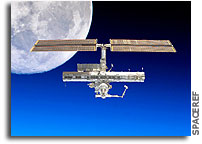ISS Science Operations Status Report 21 Apr 2003

Space Station Science Officer Don Pettit is researching fluids inside the Microgravity Science Glovebox that could be used to develop the next line of brake systems in automobiles or landing gear on airplanes. The experiment — Investigating the Structure of Paramagnetic Aggregates from Colloidal Emulsions (InSPACE) — is being conducted for the first time in the microgravity environment of space. Read more about other science activities on the Space Station.
It is research that could be used to develop the next line of brake systems in automobiles or landing gear on airplanes. An experiment onboard the International Space Station is researching a new class of smart materials or controllable fluids that can be used to do just that. It’s called the Investigating the Structure of Paramagnetic Aggregates from Colloidal Emulsions or (InSPACE).
Over the past couple of weeks, Expedition 6 Space Station Science Officer Don Pettit has been conducting runs of this experiment. The work is being done inside the Microgravity Science Glovebox — a sealed container with built-in gloves, designed to provide an enclosed workspace for investigations, which use potentially hazardous particles, fluids, or flames and fumes. InSPACE studies how particles and clumps of particles respond to an external magnetic field. It is the first time this fluid physics experiment has been conducted in the microgravity environment of space.
In addition to operating and being the subject of on board science investigations, Pettit and Commander Ken Bowersox went for a 6-hour, 26-minute space walk on April 8th. While they reconfigured critical power cables, they also completed a number of get-ahead tasks for future Space Station assembly.
As is standard with Extravehicular Activity or space walks, both Pettit and Bowersox conducted Pre and Post EVA sessions of PuFF or the Pulmonary Function in Flight experiment. This physiological study supports the continuing investigation of the effects of long-term microgravity exposure and EVA’s on lung function.
Scientists on the ground are checking out another piece of hardware in the Station’s U.S. Lab-the Commercial Generic Bioprocessing Apparatus (CGBA) –to see if it is a viable candidate to support new payloads. CGBA supports commercial life science investigations with applications in biomaterials, biotechnology, medicine and agriculture.
Middle school students around the world took command of the Space Station’s EarthKAM payload. EarthKAM (Earth Knowledge Acquired by Middle school students) allowed students from 65 different schools to command a camera to take hundreds of pictures of Earth from the Station. EarthKAM images are posted on the Internet at http://datasystem.earthkam.ucsd.edu.
NASA’s payload operations team at Marshall Space Flight Center coordinates all science activities. Planners continue to schedule activities for the rest of Expedition Six as well as Expedition Seven. The two man Expedition Seven crew is scheduled to arrive at the Station on a Soyuz spacecraft at the end of April.
For supporting materials for this news release – such as photographs, fact sheets, video and audio files and more – please visit the NASA Marshall Center Newsroom Web site at www.msfc.nasa.gov/news








